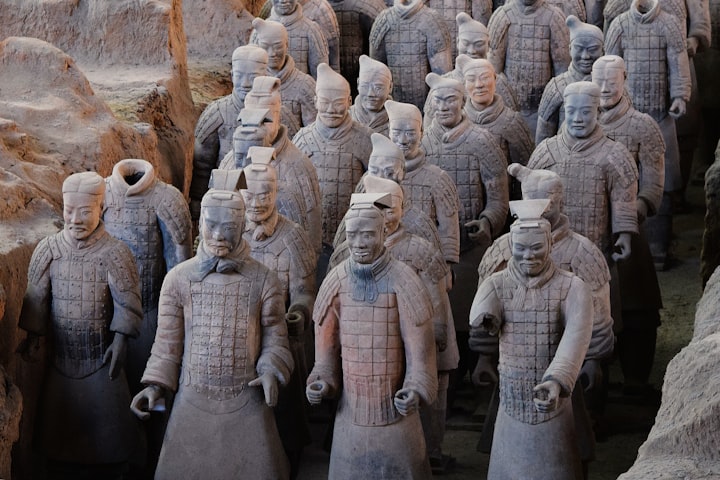The Mongol Realm: Successes, Administration, and Inheritance.
Unleashing the Mongol Storm: Conquests, Governance, and Legacy of the World's Most Powerful Empire

The Mongol Realm, one of the biggest and most remarkable domains in mankind's set of experiences, significantly affected the course of world history. Arising in the thirteenth hundred years, it immediately extended from its Mongolian heartland to vanquish an immense region of domain, extending from Eastern Europe to East Asia. In this 800-word investigation, we will dive into the ascent, victories, administration, and getting through tradition of the Mongol Domain.
Ascent of the Mongol Realm:
The groundwork of the Mongol Domain was laid by Genghis Khan, whose unique name was Temüjin. Brought into the world in 1162 on the Eurasian steppes, he joined the frequently fighting Mongol clans through a mix of political clever and military ability. Genghis Khan laid out the standards of meritocracy, discipline, and key fighting that would turn into the bedrock of the Mongol Realm's prosperity.
Successes:
The Mongol successes were out and out shocking. From their unassuming starting points in the late twelfth hundred years, they quickly extended their domain through a progression of military missions. They vanquished the Khwarezmian Domain, the Jin Administration, and the Kievan Rus, among numerous others. Their tactical achievement can be credited to a few elements.
To start with, the Mongols flaunted an imposing rangers, which was unequaled concerning velocity and portability. Their mounted bowmen were gifted at quick in and out strategies, causing extensive harm for their adversaries. Besides, the Mongols had a severe various leveled order structure and an exceptionally productive correspondence framework known as the Sweet potato. This permitted them to organize developments across tremendous distances, a critical benefit during a time before current correspondence innovation.
Second, the Mongols were capable at mental fighting. They involved dread as a weapon, utilizing strategies like the popular "misleading withdrawal," where they would pretend retreat to draw their foes into a snare. This mental fighting, joined with their merciless standing, frequently prompted foe powers giving up easily.
Third, the Mongols were realistic managers. They didn't force a uniform social or strict character on their vanquished subjects, permitting nearby rulers to keep up with their situations as a trade-off for devotion and recognition. This methodology, known as the Pax Mongolica, advanced exchange and social trade across the Eurasian landmass, as dealers and researchers moved uninhibitedly along the Mongol-controlled Silk Street.
Administration:
The Mongol Realm's administration was set apart by an exceptional mix of centralization and decentralization. Genghis Khan laid out a profoundly unified arrangement of rule with himself at the top. Be that as it may, he likewise depended on a select gathering of confided in counselors and commanders, remunerating them with power and obligation. This framework guaranteed the productive organization of a tremendous and various domain.
One of Genghis Khan's critical developments was the Yassa, a far reaching lawful code that controlled all parts of life inside the domain. It covered issues from law enforcement to exchange and even parts of day to day existence. The Yassa gave a degree of lawful consistency across the domain, advancing request and soundness.
The Mongols likewise carried out the statistics and expense framework, known as "registration and decimal tax collection." It included a normal evaluation of the populace, trailed by a computation of charges in light of a decimal framework. This tax collection framework permitted the Mongols to survey their assets and effectively dispense them.
In vanquished domains, the Mongols frequently allowed nearby rulers to hold their positions and administer their kin as long as they offered recognition and kept up with faithfulness to the Khan. This strategy, known as "circuitous rule," was logical however implied that the domain had a different and frequently decentralized managerial construction. The Mongols were able to utilize individuals from different foundations, frequently advancing legitimacy over identity, which was moderately intriguing for the time.
Heritage:
The tradition of the Mongol Realm is both mind boggling and persevering. On one hand, their successes carried obliteration and destruction to numerous districts, procuring them a standing for fierceness and savagery. Urban areas like Bukhara and Samarkand were annihilated to the ground, and endless lives were lost all the while. Notwithstanding, it's essential to recognize that their realm likewise worked with critical positive turns of events.
The Pax Mongolica, for example, advanced exchange and social trade across the Eurasian landmass. The Mongol-controlled Silk Street turned into a course for products, thoughts, and developments, like papermaking, printing, and explosive, to spread across various locales of the world.
Besides, the Mongols' advancement of strict resistance had an enduring effect. They permitted strict opportunity for their subjects, prompting a rich mixing of societies and thoughts. This heritage can in any case be found in current Focal Asia, where different strict practices calmly coincide.
In the domain of administration, the Mongols made an imprint with their managerial practices. The Yassa and registration and duty framework impacted later states, and a few standards of their standard can be seen in frameworks of administration in ensuing realms.
Moreover, the Mongol Domain had a critical segment influence. A few researchers contend that the Dark Passing, which crushed Europe in the fourteenth 100 years, was worked with by the Mongols' broad shipping lanes, which associated the East and West.
All in all, the Mongol Realm, under the authority of Genghis Khan and his replacements, made a permanent imprint on history. Their successes, however set apart by ruthlessness, encouraged a time of exceptional network and social trade. The Pax Mongolica, strict resistance, and authoritative developments keep on impacting this present reality. The tale of the Mongol Domain is one of desire, versatility, and the persevering through force of thoughts, rising above the limits of overall setting.
About the Creator
Kyrol Mojikal
"Believe in the magic within you, for you are extraordinary."






Comments
There are no comments for this story
Be the first to respond and start the conversation.